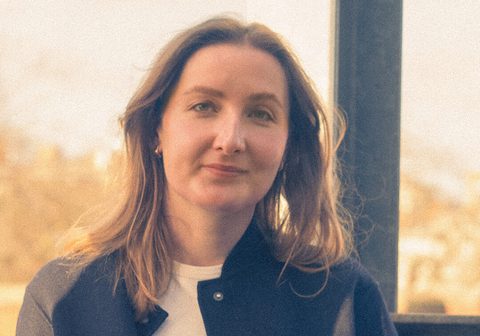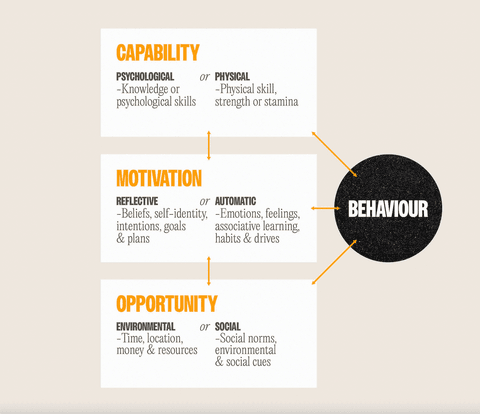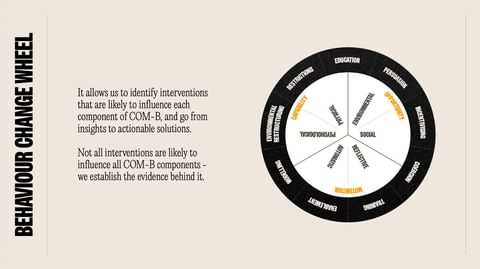NEWS ALERT - We won a SILVER IPM award for Best use of Social Media, 2025! Read more🏆

We sat down with our Head of Behavioural Science, Paulina, for a conversation about the world of behaviour change and how the team uses behavioural insights to help shape brand strategies and campaigns.
We discuss more about the COM-B model and how the team applies it to projects as well as during the creative process. Let’s find out more about the journey of changing behaviour and boosting strategies and campaigns.
“COM-B is a framework used in behavioural science to understand and drive behaviour change. It is used to diagnose the different types of factors that influence behaviour. It was originally developed by public health policy researchers at the University College London. Since then it has been tested and applied across different contexts and it's also increasingly adopted in the private sector.
To break it down let me explain what COM-B stands for:
‘C’apability
‘O’pportunity
‘M’otivation
‘B’ehaviour
Capability, opportunity and motivation are the factors influencing a behaviour. They can be looked at as positive (drivers) or negative (barriers). This model is great for categorising different types of influences on a behaviour to then match key drivers or barriers to an appropriate intervention. Each type of driver or barrier will require different interventions so carrying out this analysis makes it easier to find ways to change behaviours.”
“Capability is about a person being able to engage and interact whether it's physically or psychologically. Physical aspects may be having the strength or coordination to carry out the behaviour; as an example in the FMCG space, this might be being able to open the packaging. Psychological capability is more around awareness and whether the audience knows about the brand or product; so again in FMCG brands, it's about people knowing the benefits or nutritional value of the product.
Next is Opportunity. Opportunity is broken down into two avenues. The first is a physical opportunity, this is what’s in our environment; money, time and access to things like a computer or internet. The second is a social opportunity. As the name suggests, it's about the influence of other people and things like cultural norms, peer pressure, social support, and also any criticisms come into play as well. Again, linking to FMCG, where a lot of our projects are, we think about what’s being communicated and what kind of social norms are signalled in marketing campaigns.
Lastly, we have Motivation which can be broken down into reflective and automatic motivation. Reflective motivation is about things that influence our decisions like beliefs or values, this is referred to as ‘conscious thinking’. Then to contrast we have automatic motivation, which is usually a reaction or impulsive decision that's based on emotions and without needing to consciously think about it.
Although a lot of people know what the letters in the COM-B model stand for, many don’t realise that each category can be broken down into more specific factors and that they can all interact with each other. For example, if we look at learning to drive as a behaviour, what tends to happen is that as people gain more confidence and are capable of driving, their motivation to drive also increases as they begin to enjoy the new skill that they’re gaining.”

“We use an approach which involves three steps; Define, Diagnose and Design. It’s the foundation of our philosophy of mixing creativity with behavioural insight. Let me break down each step and explain where behavioural science comes into each stage:
First, we define what the target behaviour is that we aim to change with the campaign; it could just be one or multiple behaviours. We can map out the user journey and work out what behaviours we want to encourage
Next, we conduct a behavioural diagnosis. We begin to apply the COM-B model to identify where the drivers and barriers lie that we need to address and categorise them into the 3 types of factors.
Finally, we have the design step where we identify relevant behavioural science principles that can guide our efforts to address key behavioural factors. Here relevant teams with their respective expertise come together to work out how to apply relevant behavioural science principles to brand strategy and/or creative.This helps ensure that the overall brand strategy and creative.”
"A great example of where COM-B played a big role was our recent project with Leicestershire Police. We worked on a social impact campaign called ‘Charlie is in control’. It was an anti-drug usage campaign.
The campaign involved a dual behaviour change; one was around discouraging cocaine use and preventing associated low-level crimes, whilst the other was encouraging drug users to seek the available support.
We used COM-B to address the different types of factors at play , like the lack of awareness of the increased risk of violent behaviour when using cocaine, and the lack of awareness of available support."
“Let’s look at the FMCG industry and take a healthy snack as an example. The target behaviour is the consumer picking the healthy snack. Breaking this down into the 3 factors of the model:
First, we can think about capability; can the consumer physically open the snack? We need to ensure the packaging is easy to open to ensure it's not a physical barrier.
The psychological capability would be to establish if they understand the health benefits of the snack? Is it made clear enough?
Next is opportunity. Physical opportunity would be that the snack is easily available. Some food items are only available in certain countries, so if the consumer knows about the product but cannot access it; this would be a barrier. You want the product to be in local stores and prominently displayed. Social opportunities would involve promoting it as a healthy snack consumed by similar people; so the social media campaigns and the marketing of the product would look at the social influence and trends on behaviour, online endorsements and reviews.
Finally, we have motivation. Reflective motivation around the product would establish if the customer consciously thinks and values the health and nutritional value of the product? Whereas automatic motivation is the emotional connection to the brand or just an impulsive buy. An example is that the package triggers positive emotions that influence the customer to pick the item up.
Combining all these factors together, we can design creative and strategy around breaking the most important barriers, and drive the consumers to pick this product.”
“Yes! COM-B is our default as it's so useful and can be applied across a variety of projects however it is actually part of a broader framework called ‘The Behaviour Change Wheel’. As the name states it is a circular model which helps to identify appropriate interventions linked to key drivers or barriers of behaviour. So sometimes we use this to get a sense of direction of what types of interventions we can use.
Sometimes we also combine other models with COM-B; an example of this would be the Habit Loop, which is a really useful model for understanding how habits work. The understanding of habits mixed with COM-B allows us to think deeply about what we can do to change repeated behaviours and also help create habits and rituals..
There are lots of models and research out there and depending on the project and the outcome we will look to use the relevant information to help inform our decisions in the campaigns.”

“COM-B has been evolving ever since it was developed by testing and applying it to different industries and contexts. I don’t think it’s necessarily about expanding the model itself, it is more just about how it works in different problems and contexts.
However, an exciting thing to mention is that at MMR, the sister company of Together, we have been doing our own research into combining COM-B and AI. For example, we can guide an AI-powered chatbot to ask questions about a range of factors influencing a particular behaviour. We’ve had promising results, showing that it helps to gather richer insights about consumer decisions and behaviours.”
–
If you’re interested in learning more about how we use behavioural science in our work head over to our philosophy page or if you have a project you’d like our help with talk to the team today.